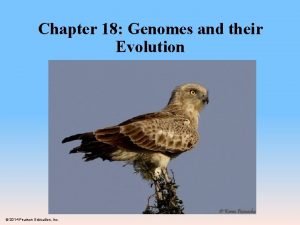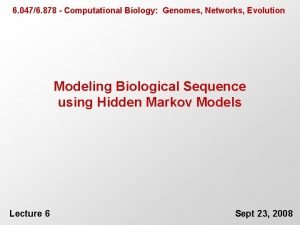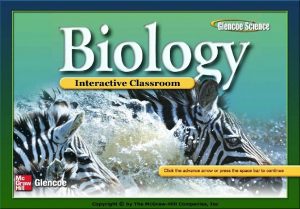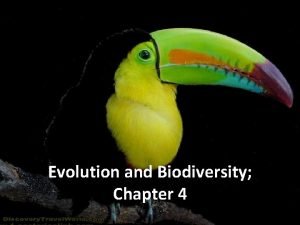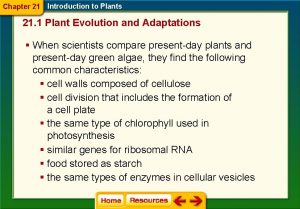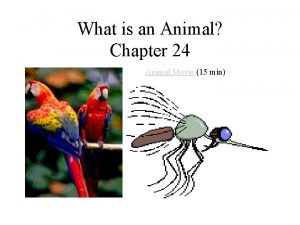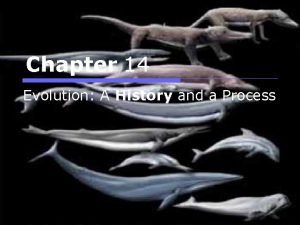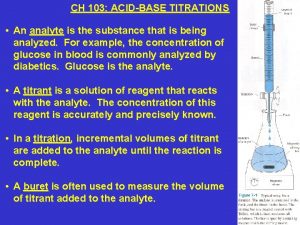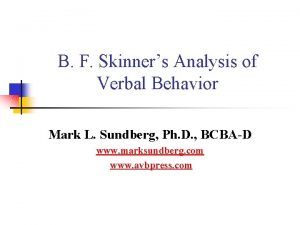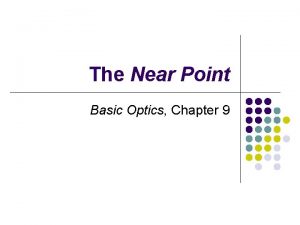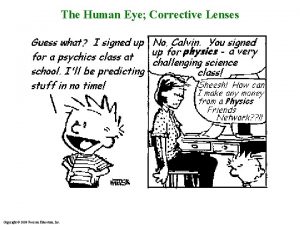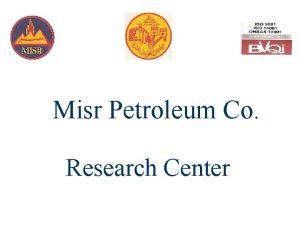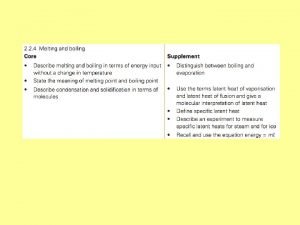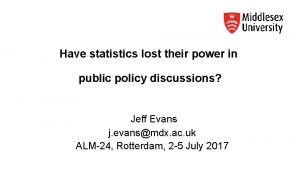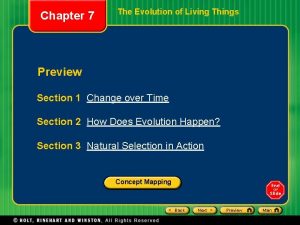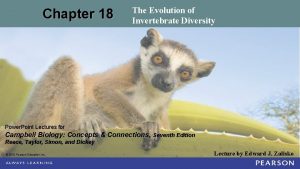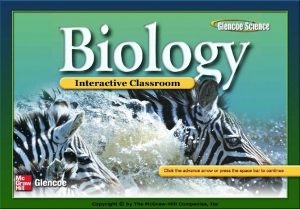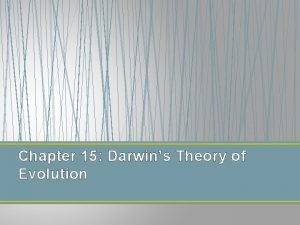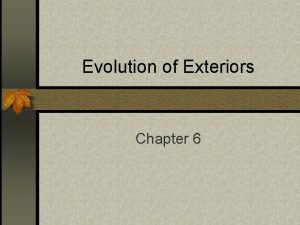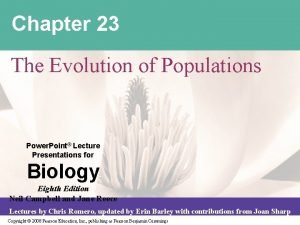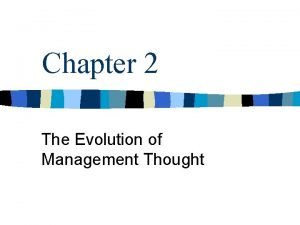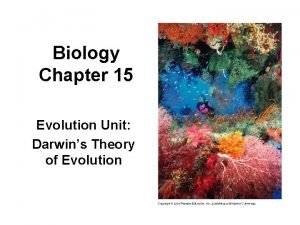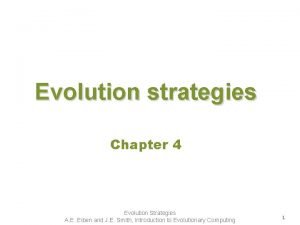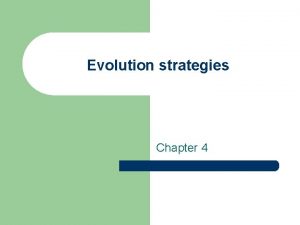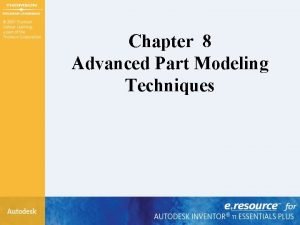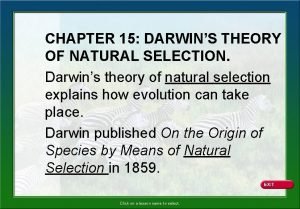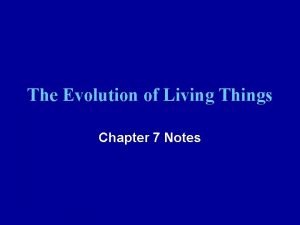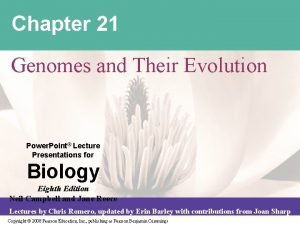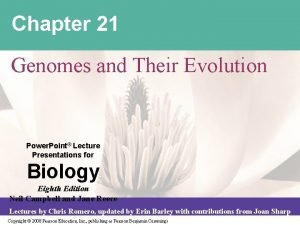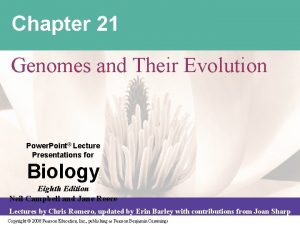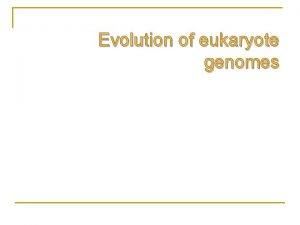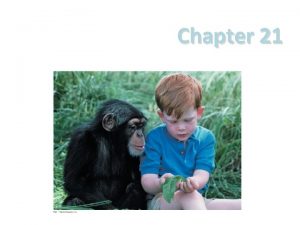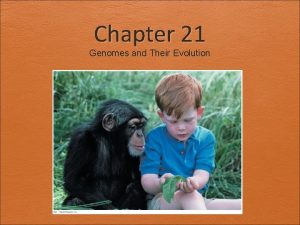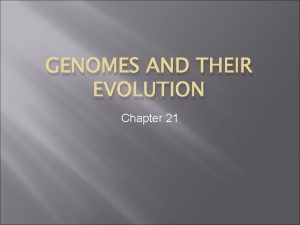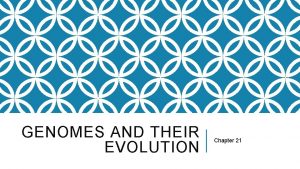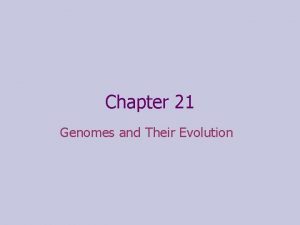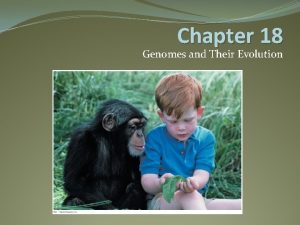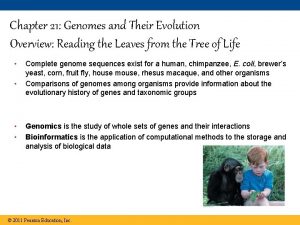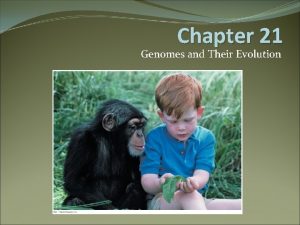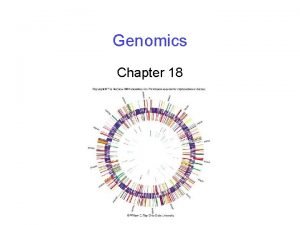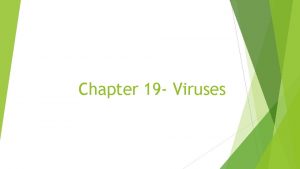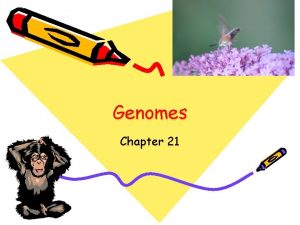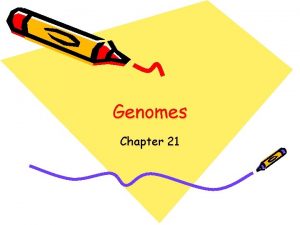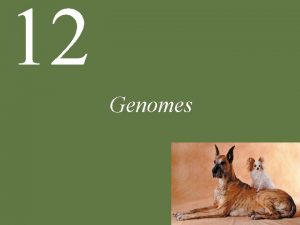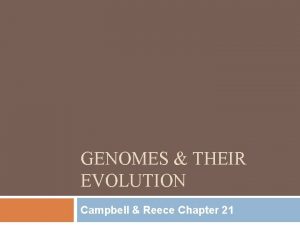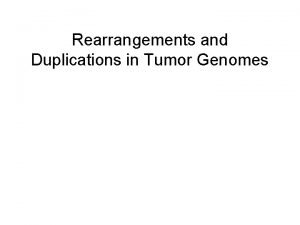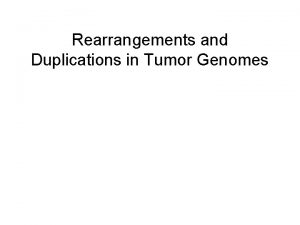Chapter 21 Genomes and Their Evolution Power Point



























































- Slides: 59

Chapter 21 Genomes and Their Evolution Power. Point® Lecture Presentations for Biology Eighth Edition Neil Campbell and Jane Reece Lectures by Chris Romero, updated by Erin Barley with contributions from Joan Sharp Copyright © 2008 Pearson Education, Inc. , publishing as Pearson Benjamin Cummings

You should be able to: 1. Explain how linkage mapping, physical mapping, and DNA sequencing each contributed to the Human Genome Project 2. Define and compare the fields of proteomics and genomics 3. Describe the surprising findings of the Human Genome Project with respect to the size of the human genome 4. Distinguish between transposons and retrotransposons Copyright © 2008 Pearson Education Inc. , publishing as Pearson Benjamin Cummings

1. Explain the significance of the rapid evolution of the FOXP 2 gene in the human lineage Copyright © 2008 Pearson Education Inc. , publishing as Pearson Benjamin Cummings

Overview: Reading the Leaves from the Tree of Life • Complete genome sequences exist for a human, chimpanzee, E. coli, brewer’s yeast, nematode, fruit fly, house mouse, rhesus macaque, and other organisms • Comparisons of genomes among organisms provide information about the evolutionary history of genes and taxonomic groups Copyright © 2008 Pearson Education Inc. , publishing as Pearson Benjamin Cummings

• Genomics is the study of whole sets of genes and their interactions • Bioinformatics is the application of computational methods to the storage and analysis of biological data Copyright © 2008 Pearson Education Inc. , publishing as Pearson Benjamin Cummings

Fig. 21 -1

Concept 21. 1: New approaches have accelerated the pace of genome sequencing • The most ambitious mapping project to date has been the sequencing of the human genome • Officially begun as the Human Genome Project in 1990, the sequencing was largely completed by 2003 • The project had three stages: – Genetic (or linkage) mapping – Physical mapping – DNA sequencing Copyright © 2008 Pearson Education Inc. , publishing as Pearson Benjamin Cummings

Three-Stage Approach to Genome Sequencing • A linkage map (genetic map) maps the location of several thousand genetic markers on each chromosome • A genetic marker is a gene or other identifiable DNA sequence • Recombination frequencies are used to determine the order and relative distances between genetic markers Copyright © 2008 Pearson Education Inc. , publishing as Pearson Benjamin Cummings

Fig. 21 -2 -1 Cytogenetic map Genes located by FISH Chromosome bands

Fig. 21 -2 -2 Chromosome bands Cytogenetic map Genes located by FISH (fluoresecent in situ hybridization) 1 Linkage mapping Genetic markers

Fig. 21 -2 -3 Chromosome bands Cytogenetic map Genes located by FISH 1 Linkage mapping Genetic markers 2 Physical mapping Overlapping fragments

Fig. 21 -2 -4 Chromosome bands Cytogenetic map Genes located by FISH 1 Linkage mapping Genetic markers 2 Physical mapping Overlapping fragments 3 DNA sequencing

• A physical map expresses the distance between genetic markers, usually as the number of base pairs along the DNA • It is constructed by cutting a DNA molecule into many short fragments and arranging them in order by identifying overlaps Copyright © 2008 Pearson Education Inc. , publishing as Pearson Benjamin Cummings

• Sequencing machines are used to determine the complete nucleotide sequence of each chromosome • A complete haploid set of human chromosomes consists of 3. 2 billion base pairs Copyright © 2008 Pearson Education Inc. , publishing as Pearson Benjamin Cummings

Whole-Genome Shotgun Approach to Genome Sequencing • The whole-genome shotgun approach was developed by J. Craig Venter in 1992 • This approach skips genetic and physical mapping and sequences random DNA fragments directly • Powerful computer programs are used to order fragments into a continuous sequence Copyright © 2008 Pearson Education Inc. , publishing as Pearson Benjamin Cummings

Fig. 21 -3 -1 1 Cut the DNA into overlapping fragments short enough for sequencing 2 Clone the fragments in plasmid or phage vectors.

Fig. 21 -3 -2 1 Cut the DNA into overlapping fragments short enough for sequencing 2 Clone the fragments in plasmid or phage vectors. 3 Sequence each fragment.

Fig. 21 -3 -3 1 Cut the DNA into overlapping fragments short enough for sequencing 2 Clone the fragments in plasmid or phage vectors. 3 Sequence each fragment. 4 Order the sequences into one overall sequence with computer software.

• Both the three-stage process and the wholegenome shotgun approach were used for the Human Genome Project and for genome sequencing of other organisms • At first many scientists were skeptical about the whole-genome shotgun approach, but it is now widely used as the sequencing method of choice • A hybrid of the two approaches may be the most useful in the long run Copyright © 2008 Pearson Education Inc. , publishing as Pearson Benjamin Cummings

Concept 21. 2 Scientists use bioinformatics to analyze genomes and their functions • The Human Genome Project established databases and refined analytical software to make data available on the Internet • This has accelerated progress in DNA sequence analysis Copyright © 2008 Pearson Education Inc. , publishing as Pearson Benjamin Cummings

Centralized Resources for Analyzing Genome Sequences • Bioinformatics resources are provided by a number of sources: – National Library of Medicine and the National Institutes of Health (NIH) created the National Center for Biotechnology Information (NCBI) – European Molecular Biology Laboratory – DNA Data Bank of Japan Copyright © 2008 Pearson Education Inc. , publishing as Pearson Benjamin Cummings

• Genbank, the NCBI database of sequences, doubles its data approximately every 18 months • Software is available that allows online visitors to search Genbank for matches to: – A specific DNA sequence – A predicted protein sequence – Common stretches of amino acids in a protein • The NCBI website also provides 3 -D views of all protein structures that have been determined Copyright © 2008 Pearson Education Inc. , publishing as Pearson Benjamin Cummings

Fig. 21 -4

Identifying Protein-Coding Genes Within DNA Sequences • Computer analysis of genome sequences helps identify sequences likely to encode proteins • Comparison of sequences of “new” genes with those of known genes in other species may help identify new genes Copyright © 2008 Pearson Education Inc. , publishing as Pearson Benjamin Cummings

Understanding Genes and Their Products at the Systems Level • Proteomics is the systematic study of all proteins encoded by a genome • Proteins, not genes, carry out most of the activities of the cell Copyright © 2008 Pearson Education Inc. , publishing as Pearson Benjamin Cummings

How Systems Are Studied: An Example • A systems biology approach can be applied to define gene circuits and protein interaction networks • Researchers working on Drosophila used powerful computers and software to predict 4, 700 protein products that participated in 4, 000 interactions • The systems biology approach is possible because of advances in bioinformatics Copyright © 2008 Pearson Education Inc. , publishing as Pearson Benjamin Cummings

Fig. 21 -5 Proteins

Application of Systems Biology to Medicine • A systems biology approach has several medical applications: – The Cancer Genome Atlas project is currently monitoring 2, 000 genes in cancer cells for changes due to mutations and rearrangements – Treatment of cancers and other diseases can be individually tailored following analysis of gene expression patterns in a patient – In future, DNA sequencing may highlight diseases to which an individual is predisposed Copyright © 2008 Pearson Education Inc. , publishing as Pearson Benjamin Cummings

Fig. 21 -6

Concept 21. 3 Genomes vary in size, number of genes, and gene density • By summer 2007, genomes had been sequenced for 500 bacteria, 45 archaea, and 65 eukaryotes including vertebrates, invertebrates, and plants Copyright © 2008 Pearson Education Inc. , publishing as Pearson Benjamin Cummings

Genome Size • Genomes of most bacteria and archaea range from 1 to 6 million base pairs (Mb); genomes of eukaryotes are usually larger • Most plants and animals have genomes greater than 100 Mb; humans have 3, 200 Mb • Within each domain there is no systematic relationship between genome size and phenotype Copyright © 2008 Pearson Education Inc. , publishing as Pearson Benjamin Cummings

Table 21 -1

Gene Density and Noncoding DNA • Humans and other mammals have the lowest gene density, or number of genes, in a given length of DNA • Multicellular eukaryotes have many introns within genes and noncoding DNA between genes Copyright © 2008 Pearson Education Inc. , publishing as Pearson Benjamin Cummings

Fig. 21 -7 Exons (regions of genes coding for protein or giving rise to r. RNA or t. RNA) (1. 5%) Repetitive DNA that includes transposable elements and related sequences (44%) L 1 sequences (17%) Introns and regulatory sequences (24%) Unique noncoding DNA (15%) Repetitive DNA unrelated to transposable elements (15%) Alu elements (10%) Simple sequence Large-segment DNA (3%) duplications (5– 6%)

Transposable Elements and Related Sequences • The first evidence for wandering DNA segments came from geneticist Barbara Mc. Clintock’s breeding experiments with Indian corn • Mc. Clintock identified changes in the color of corn kernels that made sense only by postulating that some genetic elements move from other genome locations into the genes for kernel color • These transposable elements move from one site to another in a cell’s DNA; they are present in both prokaryotes and eukaryotes Copyright © 2008 Pearson Education Inc. , publishing as Pearson Benjamin Cummings

Fig. 21 -8

Movement of Transposons and Retrotransposons • Eukaryotic transposable elements are of two types: – Transposons, which move within a genome by means of a DNA intermediate – Retrotransposons, which move by means of an RNA intermediate Copyright © 2008 Pearson Education Inc. , publishing as Pearson Benjamin Cummings

Fig. 21 -9 a Transposon DNA of genome Transposon is copied New copy of transposon Insertion Mobile transposon (a) Transposon movement (“copy-and-paste” mechanism)

Fig. 21 -9 b Retrotransposon New copy of retrotransposon RNA Insertion Reverse transcriptase (b) Retrotransposon movement

Other Repetitive DNA, Including Simple Sequence DNA • About 15% of the human genome consists of duplication of long sequences of DNA from one location to another • In contrast, simple sequence DNA contains many copies of tandemly repeated short sequences Copyright © 2008 Pearson Education Inc. , publishing as Pearson Benjamin Cummings

• A series of repeating units of 2 to 5 nucleotides is called a short tandem repeat (STR) • The repeat number for STRs can vary among sites (within a genome) or individuals • Simple sequence DNA is common in centromeres and telomeres, where it probably plays structural roles in the chromosome Copyright © 2008 Pearson Education Inc. , publishing as Pearson Benjamin Cummings

Concept 21. 5: Duplication, rearrangement, and mutation of DNA contribute to genome evolution • The basis of change at the genomic level is mutation, which underlies much of genome evolution • The earliest forms of life likely had a minimal number of genes, including only those necessary for survival and reproduction • The size of genomes has increased over evolutionary time, with the extra genetic material providing raw material for gene diversification Copyright © 2008 Pearson Education Inc. , publishing as Pearson Benjamin Cummings

Duplication of Entire Chromosome Sets • Accidents in meiosis can lead to one or more extra sets of chromosomes, a condition known as polyploidy • The genes in one or more of the extra sets can diverge by accumulating mutations; these variations may persist if the organism carrying them survives and reproduces Copyright © 2008 Pearson Education Inc. , publishing as Pearson Benjamin Cummings

Alterations of Chromosome Structure • Humans have 23 pairs of chromosomes, while chimpanzees have 24 pairs • Following the divergence of humans and chimpanzees from a common ancestor, two ancestral chromosomes fused in the human line • Duplications and inversions result from mistakes during meiotic recombination • Comparative analysis between chromosomes of humans and 7 mammalian species paints a hypothetical chromosomal evolutionary history Copyright © 2008 Pearson Education Inc. , publishing as Pearson Benjamin Cummings

Fig. 21 -11 Human chromosome 16 Blocks of DNA sequence Blocks of similar sequences in four mouse chromosomes: 7 8 16 17

• The rate of duplications and inversions seems to have accelerated about 100 million years ago • This coincides with when large dinosaurs went extinct and mammals diversified • Chromosomal rearrangements are thought to contribute to the generation of new species • Some of the recombination “hot spots” associated with chromosomal rearrangement are also locations that are associated with diseases Copyright © 2008 Pearson Education Inc. , publishing as Pearson Benjamin Cummings

Duplication and Divergence of Gene-Sized Regions of DNA • Unequal crossing over during prophase I of meiosis can result in one chromosome with a deletion and another with a duplication of a particular region • Transposable elements can provide sites for crossover between nonsister chromatids Copyright © 2008 Pearson Education Inc. , publishing as Pearson Benjamin Cummings

Rearrangements of Parts of Genes: Exon Duplication and Exon Shuffling • The duplication or repositioning of exons has contributed to genome evolution • Errors in meiosis can result in an exon being duplicated on one chromosome and deleted from the homologous chromosome • In exon shuffling, errors in meiotic recombination lead to some mixing and matching of exons, either within a gene or between two nonallelic genes Copyright © 2008 Pearson Education Inc. , publishing as Pearson Benjamin Cummings

Concept 21. 6: Comparing genome sequences provides clues to evolution and development • Genome sequencing has advanced rapidly in the last 20 years • Comparative studies of genomes – Advance our understanding of the evolutionary history of life – Help explain how the evolution of development leads to morphological diversity Copyright © 2008 Pearson Education Inc. , publishing as Pearson Benjamin Cummings

Comparing Genomes • Genome comparisons of closely related species help us understand recent evolutionary events • Genome comparisons of distantly related species help us understand ancient evolutionary events • Relationships among species can be represented by a tree-shaped diagram Copyright © 2008 Pearson Education Inc. , publishing as Pearson Benjamin Cummings

Fig. 21 -15 Bacteria Most recent common ancestor of all living things Eukarya Archaea 4 3 2 Billions of years ago 1 0 Chimpanzee Human Mouse 70 60 50 40 30 Millions of years ago 20 10 0

Comparing Distantly Related Species • Highly conserved genes are genes that have changed very little over time • These inform us about relationships among species that diverged from each other a long time ago • Bacteria, archaea, and eukaryotes diverged from each other between 2 and 4 billion years ago • Highly conserved genes can be studied in one model organism, and the results applied to other organisms Copyright © 2008 Pearson Education Inc. , publishing as Pearson Benjamin Cummings

Comparing Closely Related Species • Genetic differences between closely related species can be correlated with phenotypic differences • For example, genetic comparison of several mammals with nonmammals helps identify what it takes to make a mammal Copyright © 2008 Pearson Education Inc. , publishing as Pearson Benjamin Cummings

• Human and chimpanzee genomes differ by 1. 2%, at single base-pairs, and by 2. 7% because of insertions and deletions • Several genes are evolving faster in humans than chimpanzees • These include genes involved in defense against malaria and tuberculosis, regulation of brain size, and genes that code for transcription factors Copyright © 2008 Pearson Education Inc. , publishing as Pearson Benjamin Cummings

• Humans and chimpanzees differ in the expression of the FOXP 2 gene whose product turns on genes involved in vocalization • Differences in the FOXP 2 gene may explain why humans but not chimpanzees communicate by speech Copyright © 2008 Pearson Education Inc. , publishing as Pearson Benjamin Cummings

Fig. 21 -16 EXPERIMENT Heterozygote: one copy of FOXP 2 disrupted Homozygote: both copies of FOXP 2 disrupted Experiment 1: Researchers cut thin sections of brain and stained them with reagents, allowing visualization of brain anatomy in a UV fluorescence microscope. RESULTS Experiment 1 Wild type Experiment 2: Researchers separated each newborn pup from its mother and recorded the number of ultrasonic whistles produced by the pup. Experiment 2 Heterozygote Homozygote Number of whistles Wild type: two normal copies of FOXP 2 400 300 200 100 0 (No whistles) Wild type Hetero- Homozygote

Fig. 21 -16 a EXPERIMENT Wild type: two normal copies of FOXP 2 Heterozygote: one copy of FOXP 2 disrupted Homozygote: both copies of FOXP 2 disrupted Experiment 1: Researchers cut thin sections of brain and stained them with reagents, allowing visualization of brain anatomy in a UV fluorescence microscope. RESULTS Experiment 1 Wild type Heterozygote Homozygote

Fig. 21 -16 b EXPERIMENT Wild type: two normal copies of FOXP 2 Heterozygote: one copy of FOXP 2 disrupted Homozygote: both copies of FOXP 2 disrupted Experiment 2: Researchers separated each newborn pup from its mother and recorded the number of ultrasonic whistles produced by the pup. RESULTS Number of whistles Experiment 2 400 300 200 100 0 (No whistles) Wild type Hetero- Homozygote

Fig. 21 -UN 1 Bacteria Archaea Genome size Most are 1– 6 Mb Number of genes 1, 500– 7, 500 Gene density Introns Other noncoding DNA Higher than in eukaryotes None in Present in protein-coding some genes Very little Eukarya Most are 10– 4, 000 Mb, but a few are much larger 5, 000– 40, 000 Lower than in prokaryotes (Within eukaryotes, lower density is correlated with larger genomes. ) Unicellular eukaryotes: present, but prevalent only in some species Multicellular eukaryotes: present in most genes Can be large amounts; generally more repetitive noncoding DNA in multicellular eukaryotes
 Chapter 18 genomes and their evolution
Chapter 18 genomes and their evolution Computational biology: genomes, networks, evolution
Computational biology: genomes, networks, evolution Real power formula
Real power formula Powerbi in powerpoint
Powerbi in powerpoint Point point power
Point point power The evolution of attorney by darrell news - dirga point
The evolution of attorney by darrell news - dirga point Point to point vs hub and spoke
Point to point vs hub and spoke How did shang rulers consolidate and enforce their power?
How did shang rulers consolidate and enforce their power? How did stalin and mussolini maintain their power
How did stalin and mussolini maintain their power Romeo and juliet chorus translation
Romeo and juliet chorus translation Chapter 5 evolution and community ecology answer key
Chapter 5 evolution and community ecology answer key Chapter 21 section 1 plant evolution and adaptations
Chapter 21 section 1 plant evolution and adaptations Chapter 5 evolution and community ecology
Chapter 5 evolution and community ecology Chapter 5 evolution and community ecology answer key
Chapter 5 evolution and community ecology answer key Chapter 4 biodiversity and evolution
Chapter 4 biodiversity and evolution Anthocerophytes
Anthocerophytes Chapter 24 animal evolution diversity and behavior
Chapter 24 animal evolution diversity and behavior Chapter 14 evolution a history and a process
Chapter 14 evolution a history and a process Solar power satellites and microwave power transmission
Solar power satellites and microwave power transmission Actual power
Actual power Dispersive power of a grating is
Dispersive power of a grating is Exousia power
Exousia power Disadvantages of powerpoint
Disadvantages of powerpoint Block organization
Block organization Bubble point test formula
Bubble point test formula Points of parity and points of difference
Points of parity and points of difference One point perspective building
One point perspective building Incongruent melting point
Incongruent melting point End point and equivalence point
End point and equivalence point Formal similarity aba examples
Formal similarity aba examples Far point and near point
Far point and near point Far point near point
Far point near point Astm d 95
Astm d 95 Latent heat
Latent heat Words their way power score chart
Words their way power score chart How did the safavids consolidate power
How did the safavids consolidate power How do empires consolidate their power
How do empires consolidate their power How statistics lost their power
How statistics lost their power Chapter 16 evolution of populations vocabulary review
Chapter 16 evolution of populations vocabulary review Chapter 17 evolution of populations answer key
Chapter 17 evolution of populations answer key Strengths and weaknesses of evolutionary theory page 386
Strengths and weaknesses of evolutionary theory page 386 Chapter 7 the evolution of living things answers
Chapter 7 the evolution of living things answers Chapter 23: the evolution of populations
Chapter 23: the evolution of populations Chapter 18 the evolution of invertebrate diversity
Chapter 18 the evolution of invertebrate diversity Www.bf.tku.edu.tw/files/news chapter 17
Www.bf.tku.edu.tw/files/news chapter 17 Chapter 16 section 1 primates study guide answers
Chapter 16 section 1 primates study guide answers Chapter 16 evolution of populations
Chapter 16 evolution of populations Chapter 15 darwin's theory of evolution section 15-1
Chapter 15 darwin's theory of evolution section 15-1 Chapter 15 darwin's theory of evolution section review 15-1
Chapter 15 darwin's theory of evolution section review 15-1 The evolution of exteriors chapter 6 answers
The evolution of exteriors chapter 6 answers Chapter 6 the evolution of exteriors
Chapter 6 the evolution of exteriors Chapter 23 the evolution of populations
Chapter 23 the evolution of populations Introduction to evolution of management
Introduction to evolution of management Chapter 16 primate evolution
Chapter 16 primate evolution The fruit of evolution chapter 15
The fruit of evolution chapter 15 Advanced evolution - chapter 4
Advanced evolution - chapter 4 Advanced evolution chapter 4
Advanced evolution chapter 4 Advanced evolution chapter 8
Advanced evolution chapter 8 Natural selection
Natural selection Chapter 7 the evolution of living things answers
Chapter 7 the evolution of living things answers
